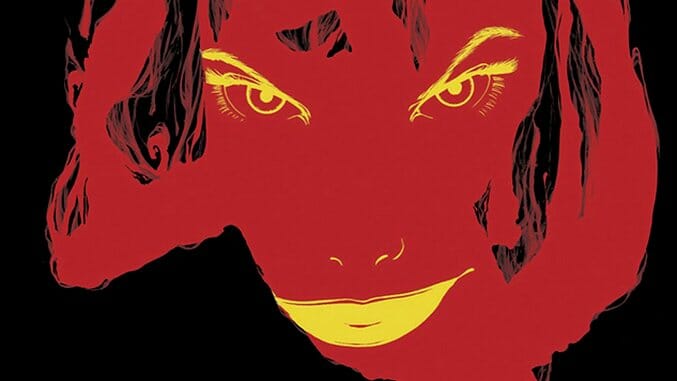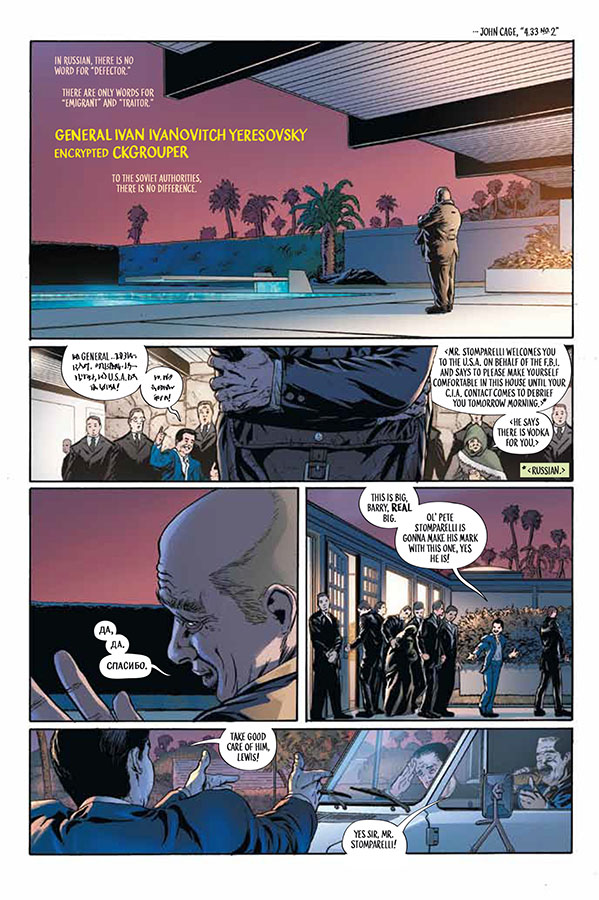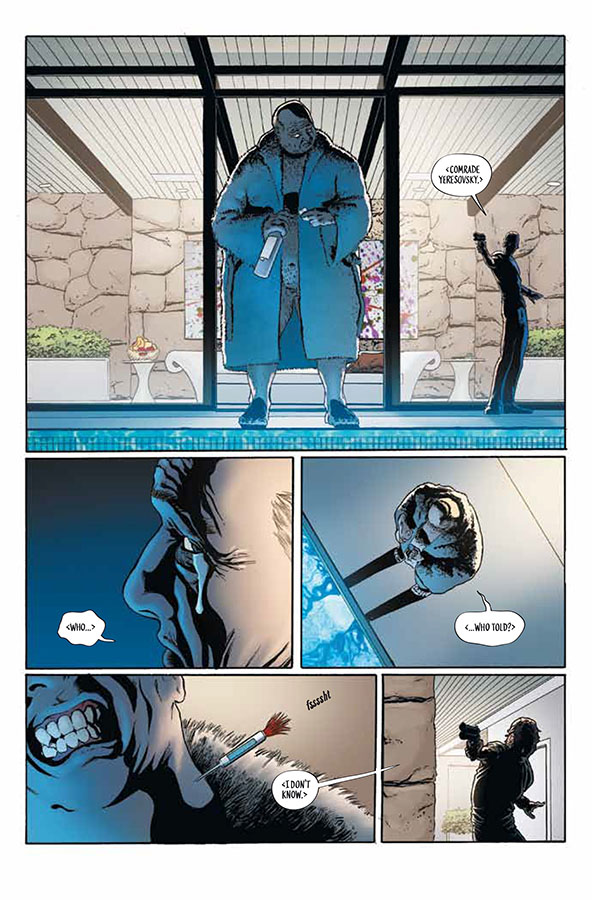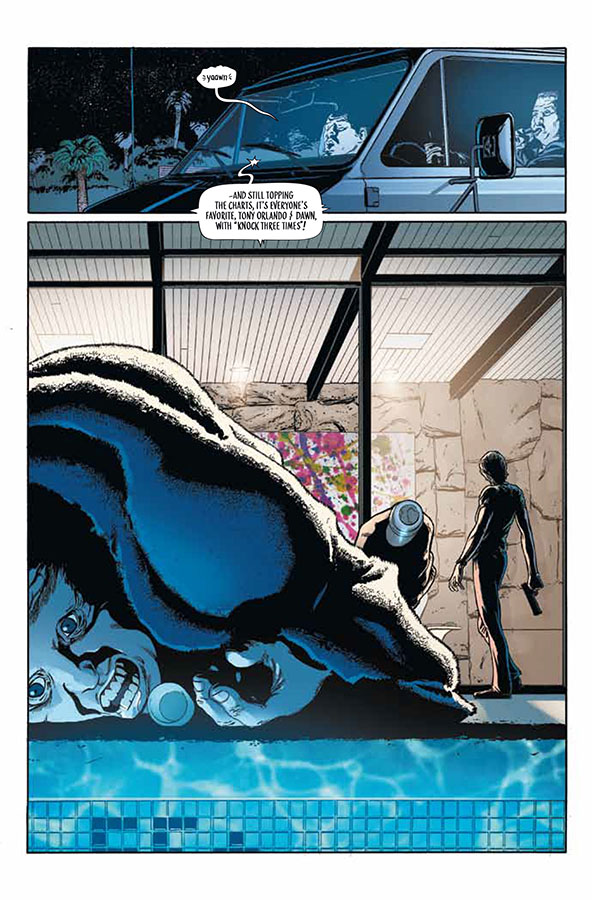“The Spy Book Is a Hilariously Calcified Genre”: Alex de Campi and Tony Parker on the Making of Mayday
Main Art by Tony Parker Comics Features Mayday
Mayday is a spy story that never quite goes to the places spy stories tend to go. The setup is simple: in the early 1970s, a Soviet general has defected and a pair of agents are sent to California on a lethal mission. What they find, however, is a maddening landscape and a collection of dangerously eccentric figures, including a sinister lawman who might have wandered in from a James Ellroy novel, hippies past their expiration date and the espionage agencies of the United States government.
Alex de Campi’s script keeps the reader on their toes, shifting sympathies back and forth between the Soviet and American camps, and revealing layers (some of them horrific and violent) to these characters as they descend further into chaos. Tony Parker’s art features a fantastic grasp of body language and nuance; it’s equally suited to thrilling action sequences and hallucinatory imagery. (This is set in early-1970s California, after all.) And Blond’s coloring adds to the sense of place, whether that’s an isolated gas station or the inside of someone’s mind. Paste talked with de Campi and Parker to learn more about the making of the book, the first issue of which released this week, and where these characters might end up next.![]()
Paste: Alex, you mention at the end of the first issue that this is intended to be the first of a number of series following these characters through the Cold War. Where did that idea come from? And was Mayday the first specific story that you came up with for them?
Alex de Campi: Mayday was always the first story. I think I came up with it a couple months after seeing The Winter Soldier movie, and then a vague Huh, that’s kind of interesting, I wonder what that character was doing in the 1970s gradually turned into But what if Terrence Malick’s Badlands with Soviets? (Or, indeed, Zabriskie Point. Or, y’know, Easy Rider, to stay hep to the nascent Captain America theme.) Late 1960s and early 1970s auteur films have always been a real touchstone of mine in terms of my storytelling style—that and folks like Naoki Urasawa in comics. Which is to say, I’m fundamentally a character writer, who goes for a probably unnecessarily large amount of emotional realness in writing what is ultimately genre fiction. So I wanted young operatives, not in suits, in the wide-open modernist spaces of Palm Springs, and I wanted a lot of blood on the sand. And sex. And drugs. And people wildly out of their depth. And then in constructing the story, and researching it, the characters became very specific people with very long-term arcs.
I picked 1971 because I already knew I wanted to set the story in California (not a very oft-trodden path for the Cold War spy drama) and choosing ‘71 let me end with the May Day Riots in San Francisco. But then… the history of the years following—well, the espionage history—was so fascinating. Able Archer (my end point, really, although there will be a coda during/after The Year of the Spy). The Soviet-Afghan War, and the ugly roots of American involvement in Afghanistan. Munich 1972, Nixon in Russia 1972, the Baader-Meinhof group. The PLO. Mysterious deaths, like Peter Valyi. There is an embarrassment of stories to tell through the 1970s, not just the big ops, but the office politics. And Felix and Rose, growing up the hard way, making terrible decisions about each other. Jack and Penny, navigating the moral ambiguities of their chosen professions. I mean, of course I kill some of them, but you have to wait to see who.
I didn’t want to do the book merely as an ongoing, because…because making stuff is hard. I do the best I can, every time. I leave a lot of myself on the page. And sometimes I need a little breather. So if we structure the long narrative as a chain of self-contained miniseries, then we can have that break. And it’s less off-putting to new readers, say, to come on at the #1 of The Brandenburg School for Boys, rather than #6 of an ongoing. Or #1 of whatever I re-name The Red Arrow, now that I’m setting it on the Dacia Express rather than, y’know, The Red Arrow, rather than #11 of an ongoing. (I think I’m going to rename it Vienna Station, but still not sure.) Mayday is the only story set in the US, though.

Mayday #1 Interior Art by Tony Parker and Blond
Paste: Does the story that plays out over the five issues of Mayday take inspiration from any actual CIA or KGB activity?
de Campi: It isn’t a white-label/fictionalization of a specific op from either side. (I’m not that lazy… yet. Although there are some fascinating ops.) It’s more mosaic-theory stuff—a little here, a little there, and you make up a whole new story from tiny bits of truths of other stories. I’ve read, heavens, a dozen? a score? of Cold War (CIA, KGB, Stasi, DIE/Securitate, Soviet foreign ministry) autobios, plus a few histories of specific ops and terrorist groups. They contributed a huge amount of operational minutiae that hopefully will make the book feel quite authentic, though I freely admit to handwaving some of it. What they contributed more importantly to me was really getting at some of the emotional truths of what people in those positions were going through: the absolute terror of being “black”/under cover in a foreign country; the painstaking deskwork and planning combined with ridiculous and (in 20/20 hindsight) completely avoidable errors. The lack of knowledge of even basic things about the other side…the bitter regret and depression of many defectors. There’s a scene in issue four of Felix in the fruit section of this blindingly bright, clean California supermarket, that comes directly out of some of the stories of Russians coming over to the US for the first time. Oranges. Great pyramids of them. With no guards! And bananas! And pineapples (wtf are those).
The research reading has tipped mildly over into a sort of benign obsession because it is so good. (I’ve always been a history nerd, so…) There are a few anecdotes, just throwaway paragraphs, that you could write whole novels about… and I may just. Mischa Wolf talking about the Soviet Intelligentsia being pulled out of Moscow to safety in the Urals as Hitler marched on the capitol, and Sergei Eisenstein deciding to get everybody involved to make a film, to take their minds off the invasion. (The “Let’s Put On A Show” trope is the best trope. Also, Eisenstein! Best things!) And of course I really need to spend six months writing a closed-room attempted murder mystery set on Khrushchev’s boat to the UN in 1960 that stars precisely zero non-Warsaw Pact characters, thanks to another brief anecdote. I can just picture my literary agent’s face when I tell him.
Paste: One thing that struck me as I was reading the first two issues was the way in which the reader’s sympathies shift; for one thing, Felix is capable of going from pitiable to coldly lethal. How did you find the right balance for these characters?
de Campi: I wing it. I wish I had a better answer for you than that, but that’s the true answer. You set up your character really well in terms of knowing who they are and why they do things, and then you throw them in situations and the whole piece takes up a rhythm, like it was a piece of music. It’s gut instinct, how far you can push a feeling, or a scene, or a character, before having to twist the narrative and bring them back. Humanize them; bring in a more gentle theme for a few bars. I’ve also had an extremely misspent youth, and I think that’s helped in an odd way… I know how violence happens in real life, and tragedy, and how your brain seizes on details, or absurdities, in those moments. And I’ve been friends with a fair few soldiers.
With Felix in particular, he is so out of his element in the everyday, clean, spacious world of California, he’s actually more comfortable the worse things get, because it brings him back to territory he understands. (Rose is the opposite—at ease in this bright capitalist hell, but at sea when things go wrong.) Felix is not well educated; he’s never been outside the Soviet Union, and nobody’s ever really bothered with him in terms of making him feel like a worthwhile human being. He can kill a person without flinching. But there is something interesting in there, something that wants to be different, and over the longer arc of these stories we’re going to see him develop a lot.
It’s funny. When you’re learning to write (or to act), you learn all this framework stuff, how does your character drink their tea, what was their relationship with their parents, do they cross their legs or spread when they sit, blah blah blah, and it feels so artificial and shit and hard, and then ten years later it all comes automatically, you don’t even have to think about it—you just know. (Felix: with jam, orphan, spreads. Rose: with lemon—her family were nomenklatura, theoretically loving but with significant toxic elements, crosses.)
Overall, thematically, it’s important that Felix is very lethal, to the point where it skates the line of being repulsive. Take the spy out of the suit. Put him in jeans and a hoodie. Give him a lower-class/foreign accent. And what I want to know is how do you like your blue-eyed Bond now? The spy book is a hilariously calcified genre, and one of the things we intended to do with Mayday is just…smash that a little bit. Do small things that make everything feel much fresher, much more modern, then tuck it back in the comforting sugarcoat of history so it wasn’t too modern, too now. And the way I write violence, it’s very indebted to folks like Cormac McCarthy and Sam Peckinpah. I don’t write violence for you to get off on its balletic white-exceptionalist power fantasy. I write it to make you uncomfortable. I want you to finish these scenes and think, Jesus Christ, I never want this to happen to me. Because, protip: you don’t.

Mayday #1 Interior Art by Tony Parker and Blond
Paste: Tony, there are a few pages in the first issue that make use of a number of very wide, fairly low panels, where the subjects’ faces are cropped out. What prompted that approach?
Tony Parker: Parts were in Alex’s script, while others were my choice. In the beginning, it allows for some build up to the character. Different visual icons establish the sense of the character before we see their face. Other places it forces the reader to focus on the gestures and words, giving them a greater weight and impact.
Paste: The script features the use of vague characters in dialogue to represent English words that the Russian characters don’t understand. How did you arrive on that as a way to indicate the language gap?
de Campi: I’ve spent a lot of time in places where I don’t speak the language, and so the nonsense characters were my attempt to get across the feeling of understanding that someone was speaking, but maybe only catching one word in ten. It’s exhausting, walking around swaddled in a big blanket of enforced silence. (If you met me in person, I make faces a lot, and talk with my hands… I think it’s a remnant of those years. You get really good at nonverbal communication and reading physical/tonal cues, because a funny face and a hand gesture wins you an extra few seconds to feverishly try to think of the words in the foreign language.) And as you get tired, it gets harder to understand—even when you are okay at the language.
A huge part of this book stands or falls on whether I can make you experience the strangeness that I, and that our Russian characters, see when they look at America. Their fascination, and confusion…and fear. Distancing/dissociating you through language is a specific tool to make you feel that: how much they are not fitting in. That feeling of improvising wildly in a culture where you don’t know the rules, and can’t ask. And these are Soviet operatives, they can’t blow cover or they’re dead. They just have to fake it as best they can.

Mayday #1 Interior Art by Tony Parker and Blond
Paste: Tony, there’s a section in the first issue where one character ingests a hallucinogen, and the narrative suddenly turns much stranger. How did you work out how to show his perceptions changing without going fully abstract?
Parker: Oh, that was a fun sequence. My first goal was to make sure that it was still visually readable to the viewer. From there, it was a gradual shift as the drugs kicked in. It’s more natural as to the actual effect, and it isn’t a jarring transition to the reader. After that, it was just having fun with it. Big shout out to Blond, who colored the book, and really nailed that sequence.
Paste: Alex, the pages of this book include a built-in playlist, including a haunting use of Steve Reich’s “It’s Gonna Rain” in the second issue. How far into the scripting do the sonic cues come into play?
de Campi: Steve Reich for the win. That piece works so well for that scene. I love using unexpected songs for shootouts… someday I’m going to write my British gangster revenge film and the climactic third-act shootout will be at a stately home, to Lord Kitchener’s “London is the Place For Me”.
The song listing came in very early. I’ve always made playlists, even back when they were on Maxell 90s with white-out over the label, recorded off the radio. I make a rough outline for the story and a rough playlist at the same time, and then both progress forward in the same way with tweaking and sequencing and adding and deleting. I ask myself, when I see this scene play out in my mind, is this the right score for it? How well does it add atmosphere, or subtext, or counterpoint? Is it a good song? (Or is it a deliberately terrible song, employed for specific purpose?) Often the music becomes diegetic, played on a radio or an 8-track.
It’s also been tremendous fun upending the casual assumptions about the music of an era. The Mayday playlist is very much about anger and psychedelia and new forms/ways of making music (hence the presence of Reich, and later, Sun Ra and Zappa). I really wanted it to be mostly stuff that people wouldn’t be familiar with from classic rock radio stations…though we do have a Led Zep song and a Doors song.

Mayday #1 Interior Art by Tony Parker and Blond
Paste: The inside front covers for the first two issues feature Jane Fonda and Charles Manson, respectively.
de Campi: Although there are a lot of parallels between 1971 and today, for the average reader the setting will feel very distant. (It’s deliberate—easier to make hard subjects palatable via the distancing of history than if I set the story right now using our current basket of terrors.) So I try to do things to give the reader more of a feel of the time, in fun, non-didactic ways. The soundtrack is one such method. Focusing on famous criminals of the era is another such. Every inside front cover features a quote and a mug shot of someone that was arrested, incarcerated or being tried that year. Issue one has Jane Fonda giving her black-power salute and burbling about how property is theft, when we introduce our communists.
I have a strange sense of humor and bringing actual Soviets in contact with selfish, free-love, commune-living West Coast potheads was just too good to ignore. Because of those guys, by 1971 the hippie movement was everything vile about capitalism rolled up into one sweaty, patchouli-stinking ball, but with a window-dressing of sound-byte Marxism. (Thank God Iggy Pop killed the ‘60s. In Stooges We Trust.) Then in the drug hangover/violence issue, we move on to another criminal celebrity, dear Mr. Manson…and then right-wing poster child Lieutenant Calley. And so forth. I’m thinking about throwing a few period-appropriate ads in too…. Keep an eye out for the back cover of issue two. I have plans.
My books are laboratories, in so many ways. My first job is telling you an entertaining narrative that hauls you along and drops you at the far end, dazed and breathless. But around the edges of that, there is always room for play: experimenting with making native speakers feel what it’s like to be somewhere that you can’t understand everything that’s going on. Shifting your alliances and affections as we see how far we can make a character act like a terrorist before you stop liking him. Painting a specific period in time for you with criminals, quotes, music and other ephemera. Giving you a strong female character who never fires a shot or throws a punch. Some of my games will land. Some won’t. That’s okay. If you’re not failing sometimes, you’re not writing, you’re just typing.
